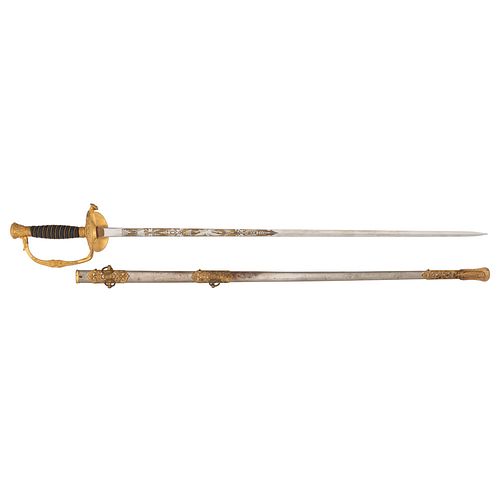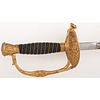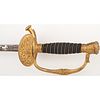A.J. Plate Model 1872 Field and Staff Officer's Sword Presented to Medal of Honor Winner General Nelson Miles, by the Company Officers of the 5th Infa
About Seller
6270 Este Ave.
Cincinnati , OH 45232
United States
With offices in Cincinnati, Cleveland and Denver, Cowan’s holds over 40 auctions each year, with annual sales exceeding $16M. We reach buyers around the globe, and take pride in our reputation for integrity, customer service and great results. A full-service house, Cowan’s Auctions specializes in Am...Read more
Two ways to bid:
- Leave a max absentee bid and the platform will bid on your behalf up to your maximum bid during the live auction.
- Bid live during the auction and your bids will be submitted real-time to the auctioneer.
Bid Increments
| Price | Bid Increment |
|---|---|
| $0 | $25 |
| $500 | $50 |
| $1,000 | $100 |
| $2,000 | $250 |
| $5,000 | $500 |
| $10,000 | $1,000 |
| $20,000 | $2,500 |
| $50,000 | $5,000 |
| $100,000 | $10,000 |
About Auction
Sep 2, 2020
Featuring the remarkable collection of Lore and Dave Squier (Lots 1-171), this auction promises to be the most important sale of fine Japanese Arms and Armor since the Dr. Walter Compton Collection in 1992. Cowan's Auctions dawnie@cowans.com
- Lot Description
29" spearpoint blade, .5" wide at ricasso. Single-branch hilt with folding clamshell guard and wire-wrapped shagreen grip. Blade etched with patriotic themes, panoplies of arms, and "U.S.," with gold wash. Steel scabbard with brass fittings and plate engraved in script "Presented to General Nelson A. Miles/from the Staff & Company Officers/of the 5th Infantry U.S. Army."
One of the most famous Generals in American military history, General Nelson Appleton Miles (1839-1925) started his military career as a Lieutenant in the 22nd Massachusetts Infantry in September 1861, later earning a commission as a Lieutenant Colonel in the 61st New York Infantry in May 1862. After the Battle of Antietam, where the 61st saw heavy action at the Sunken Road, he was promoted to Colonel. The 61st would continue to win glory in the field, with Miles himself suffering four wounds in battle, two to the abdomen and stomach. By war's end, Miles had risen to the rank of Brevet Major General of Volunteers, with an official promotion to that rank in October 1865. Post-war he had the distinction of commanding Fort Monroe in Virginia, where former Confederate President Jefferson Davis was held prisoner.
Miles would continue his military service in the regular army, accepting a commission of Colonel (while a brevet of Major General in the Regular Army) of the 40th U.S. Infantry in July 1866, taking command of the 5th U.S. Infantry in March 1869. During his time with the 5th Infantry, Colonel Miles would participate in pitched battles against the Kiowa, Comanche, and Cheyenne during the Red River War and the Great Sioux War of 1876. He would spend the next decade in the West, suppressing Indian uprisings, the Apache proving especially difficult to subdue. The "Ghost Dance" uprising of the Lakota brought Miles back to field command, where he desired to pursue a peaceful resolution to the issue. After hearing of the Massacre at Wounded Knee, a disgusted Miles wrote to his wife that the event was "...the most abominable criminal military blunder...". For years afterward, he repeatedly petitioned the Federal Government for compensation payments to the survivors.
In 1892, Miles was recognized for his action at the Battle of Antietam with the Congressional Medal of Honor, three years later being appointed the Commanding General of the United States Army. In this capacity he commanded American troops during the Spanish American War and Invasion of Puerto Rico. As the mandatory retirement age of 64 loomed in his future, he was desperate to prove that he was still able to command. To this end, he rode 90 miles on horseback from Fort Sill to Fort Reno in eight hours, with temperatures reaching up to 100 degrees Fahrenheit. Despite his ride being the longest ever undertaken by a commanding General, he retired in 1903. After his retirement, the office of Commanding General of the United States was abolished.Blade is in a good state of polish with some wear to gold wash. Good attractive gilt remaining on hilt. Some rust and scratching to scabbard with some wear to gilt on fittings.Condition
- Shipping Info
-
Buyers are required to pay for all packing, shipping and insurance charges. Overseas duty charges are the responsibility of the successful Bidder. Be aware that for larger and/or valuable items, shipping charges can be substantial. - If there is no shipping amount on listed your invoice, you will need to make arrangements to pick up or ship your purchase through an alternative shipping company. Our shipping department can be contacted at 513.871.1670 (ext. 219) or email shipping@cowans.com. - Shipping charges include insurance for your order while in transit. If you have private insurance we will adjust your charge to include only packing and shipping. - Please allow 14 – 21 days after payment to package and ship your purchase as carefully as possible.
-
- Buyer's Premium



 EUR
EUR CAD
CAD AUD
AUD GBP
GBP MXN
MXN HKD
HKD CNY
CNY MYR
MYR SEK
SEK SGD
SGD CHF
CHF THB
THB



















